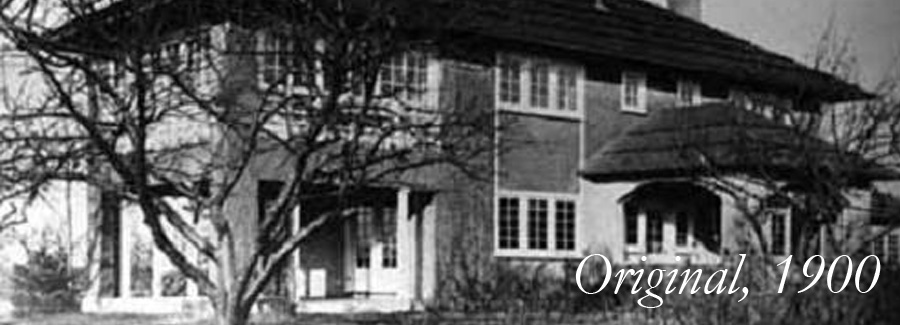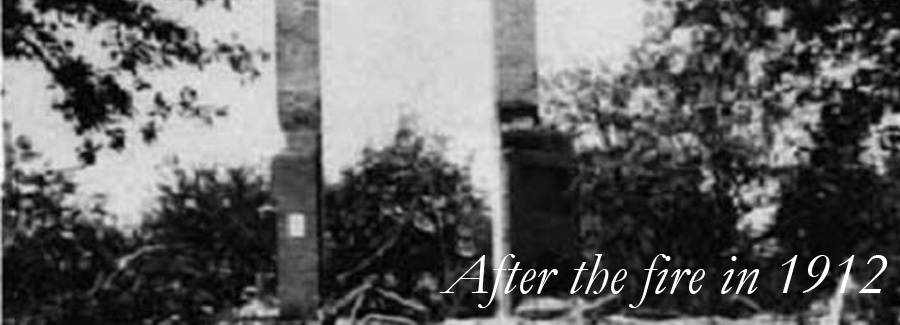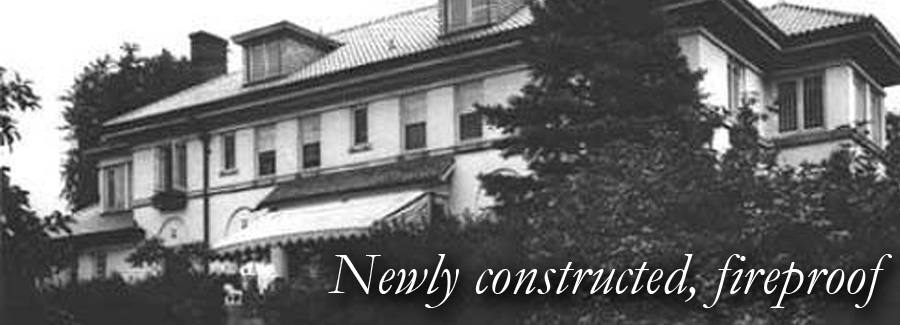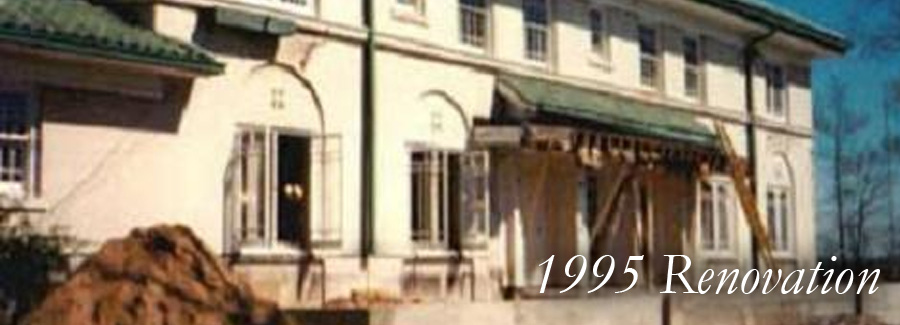History
The earliest account we have for ownership of the property where The Belvedere Inn now stands dates back to 1864. During this year, it is thought the property was purchased on speculation from the US government. In the ensuing years, it changed ownership several times until 1897 when the Comstock family of Chicago purchased the site to build their summer residence.Belvedere and The Gilded Age
The end of the 19th and beginning of the 20th century was a period of tremendous advancement in industry and great prosperity in the United States.
This period named The Gilded Age by Mark Twain, resulted in enormous personal fortunes for select individuals and their families in cities like Chicago and New York. The Comstocks and later the Williamsons, who built Belvedere, were Chicago beneficiaries of this prosperity.
In enormous displays of extravagance, wealthy families of The Gilded Age built large summer homes in popular resort areas. While New Yorkers favored Newport, Rhode Island, residents of Chicago flocked to Saugatuck, Michigan. These families generally occupied their sumptuously appointed summer residences for only a portion of the summer. The Williamsons spent only two months each year at their summer estate.
Today, Belvedere is one of the few remaining Saugatuck-area, Gilded Age mansions which is fully restored and open to the public.
The Comstock Farm
In 1897 the Comstock family of Chicago built a large and elegant wood frame house with a stucco exterior on the current site of Belvedere. The family also built a stately barn to the north, the (gardener's) cottage nearby and several outbuildings, all of which still exist. The Comstock estate was both a summer residence and functioning fruit farm. Grown were 29 varieties of apples, 12 of pears, peaches, plumbs, grapes, and numerous berries. The fruit was shipped to Chicago via the fruit docks located in Saugatuck.
The Comstocks and later the Williamsons, as well as the next owners of Belvedere, the Leonards, traveled to their summer estate from Chicago by Interurban train, the major means of transport in the Midwest between cities, towns and villages during The Gilded Age. Belvedere Farm was the only private stop between Saugatuck and Holland, Michigan. The Interurban waiting station stood until the 1960s and is pictured here. The original sign "BELVEDERE", which identified the stop, now hangs above the entrance to The Belvedere Inn.
In the spring of 1912 the Comstock farm was sold to Mr. and Mrs. John D. Williamson for $100,000. Mr. Williamson was the vice president of the Peoples Gas and Electric Company in Chicago.
After a fire in 1912, this is all that remained of the Comstock mansion.
The following June, less than six weeks after the Williamsons purchased the summer estate, a thunderstorm swept through the area and lightning struck the wood shingled mansion at 4:00 AM on a Sunday morning. The family escaped to the gardener's cottage in their nightclothes and watched helplessly as their newly acquired summer residence burned to the ground. Mr. Williamson later had the ashes sifted and recovered all of his wife's diamonds.
The Williamsons decided to rebuild, on the same site, a new structure that would be "fireproof". The new and current house's design borrowed from the Chicago Prairie style of architecture popularized by Frank Lloyd Wright. Natural building materials and strong horizontal lines characteristic of the Prairie style dominated Belvedere's architectural design. The Big House was built with 12" thick masonry walls, quarter-sawn oak interior trim, a green tile roof, and copper exterior fixtures. A large water tower for added fire protection was constructed west of the Comstock barn and still exists today. The new house was named "Belvedere" which is Italian for "beautiful view" and "summer house commanding a fine prospect". At that time Goshorn Lake, Lake Michigan and the sand dunes were clearly visible from the Big House - the term always used when referring to the mansion.
Mr. Williamson also constructed a large tenant farmhouse and a hip-roof barn across the Interurban tracts. Both still stand and the barn is now Saugatuck's Red Barn Summer Playhouse.
In 1920 Belvedere Farm was traded in a Chicago real estate transaction to Earl Leonard, who in turn gave the estate to his new bride, Sue. In 1975 Mrs. Leonard reflected on the first time she saw her wedding gift. "The Big House was magnificent, beautiful, it took my breath away. My sister and I entered the house at 10:00AM and immediately began exploring the fully furnished house. There were 100 sets of linens! We didn't stop to take our hats off until 5:00PM that afternoon!"
After three years the Leonards explored selling the western portion of the farm including the Big House to another wealthy Chicago resident. Dorr Eugene Felt, inventor of the Comptometer (forerunner to the adding machine), considered buying the mansion to move it to Shore Acres, his estate in the Lake Michigan sand dunes between Saugatuck and Holland. It wasn't possible. In the 1940s there were unrealized plans for using the Big House as a preparatory school for the sons of wealthy Chicago families. A teacher was hired but all that resulted was the printing of a brochure.
Since then, there have been several owners and many uses for the Big House of Belvedere Farm. From 1941 to 1963 the Thomas Rozema family, originally of Chicago, owned the estate.
From 1963 to 1987 the Stanley Ellens family owned Belvedere and lived for a time in the rooms of the Williamson's original master suite, while making improvements to the rest of the building. The Ellens owned the Big House longer than anyone in its rich history.
In 1995, the Big House was comprehensively restored by John Lottie, including the reinstallation of several discovered original appointments such as French doors and important interior and exterior light fixtures. The property was converted into a beautiful Bed and Breakfast Inn. In 1998 Dick and Marge Darby of Holland, Michigan, purchased the Big House. The Darbys continued to enhance the house and grounds to make your stay at the "Belvedere Inn" both elegant and relaxing.
In May of 2003, Shaun Glynn, a Chicagoan, acquired The Belvedere. With over 20 years of hospitality and business experience, Shaun has truly taken The Belvedere to the next level of excellence. Continuing with the renovations, the Inn has been tastefully decorated. All guest rooms have luxurious amenities expected by today's travelers. Additions of whirlpool tubs and fireplaces and maintaining an award winning restaurant, Shaun has created the ultimate lodging and dining experience. Shaun's sincere passion for entertaining shows throughout the Inn & Restaurant.
Now, with its stately manicured gardens, often referred to as a Mini Versailles, The Belvedere is a highly sought after destination spot for travelers, Weddings and Special Events. This house looks as good as it ever has in its wonderful rich history. We are glad you are living and enjoying a part of it with us!
In 1920 Belvedere Farm was traded in a Chicago real estate transaction to Earl Leonard, who in turn gave the estate to his new bride, Sue. In 1975 Mrs. Leonard reflected on the first time she saw her wedding gift. "The Big House was magnificent, beautiful, it took my breath away. My sister and I entered the house at 10:00AM and immediately began exploring the fully furnished house. There were 100 sets of linens! We didn't stop to take our hats off until 5:00PM that afternoon!"
After three years the Leonards explored selling the western portion of the farm including the Big House to another wealthy Chicago resident. Dorr Eugene Felt, inventor of the Comptometer (forerunner to the adding machine), considered buying the mansion to move it to Shore Acres, his estate in the Lake Michigan sand dunes between Saugatuck and Holland. It wasn't possible. In the 1940s there were unrealized plans for using the Big House as a preparatory school for the sons of wealthy Chicago families. A teacher was hired but all that resulted was the printing of a brochure.
Since then, there have been several owners and many uses for the Big House of Belvedere Farm. From 1941 to 1963 the Thomas Rozema family, originally of Chicago, owned the estate.
From 1963 to 1987 the Stanley Ellens family owned Belvedere and lived for a time in the rooms of the Williamson's original master suite, while making improvements to the rest of the building. The Ellens owned the Big House longer than anyone in its rich history.
In 1995, the Big House was comprehensively restored by John Lottie, including the reinstallation of several discovered original appointments such as French doors and important interior and exterior light fixtures. The property was converted into a beautiful Bed and Breakfast Inn. In 1998 Dick and Marge Darby of Holland, Michigan, purchased the Big House. The Darbys continued to enhance the house and grounds to make your stay at the "Belvedere Inn" both elegant and relaxing.
In May of 2003, Shaun Glynn, a Chicagoan, acquired The Belvedere. With over 20 years of hospitality and business experience, Shaun has truly taken The Belvedere to the next level of excellence. Continuing with the renovations, the Inn has been tastefully decorated. All guest rooms have luxurious amenities expected by today's travelers. Additions of whirlpool tubs and fireplaces and maintaining an award winning restaurant, Shaun has created the ultimate lodging and dining experience. Shaun's sincere passion for entertaining shows throughout the Inn & Restaurant.
Now, with its stately manicured gardens, often referred to as a Mini Versailles, The Belvedere is a highly sought after destination spot for travelers, Weddings and Special Events. This house looks as good as it ever has in its wonderful rich history. We are glad you are living and enjoying a part of it with us!
Much of the historical information herein was provided by Kenneth L. Ellens. We apologize for any misinformation.
Belvedere archival photos and history are the exclusive property of Kenneth L. Ellens. They are presented here with his permission and may not be reproduced in full or part without his written permission.
Ken Ellens lived in Belvedere's Big House from 1963-1965 as young boy with his family. He extensively researched Belvedere's history in 1975, interviewing many previous owners (including Mrs. Leonard who received the estate as a wedding gift in 1920), their children and former staff.
Belvedere archival photos and history are the exclusive property of Kenneth L. Ellens. They are presented here with his permission and may not be reproduced in full or part without his written permission.
Ken Ellens lived in Belvedere's Big House from 1963-1965 as young boy with his family. He extensively researched Belvedere's history in 1975, interviewing many previous owners (including Mrs. Leonard who received the estate as a wedding gift in 1920), their children and former staff.



